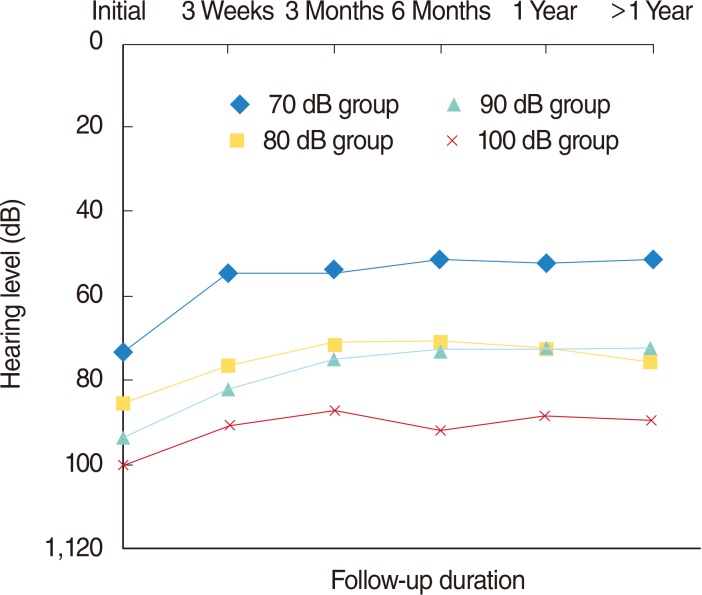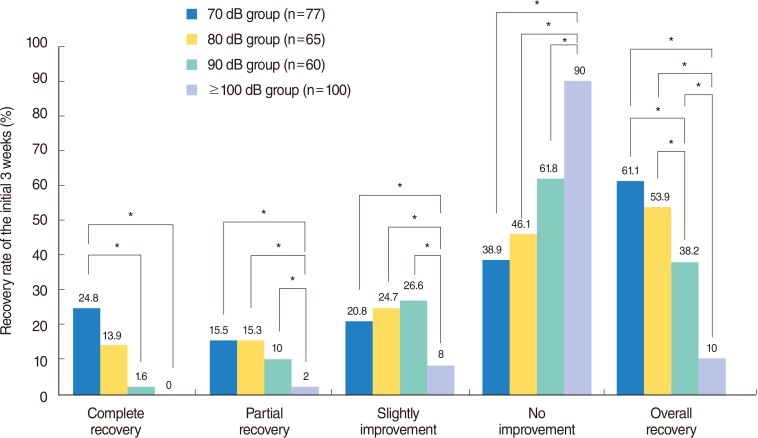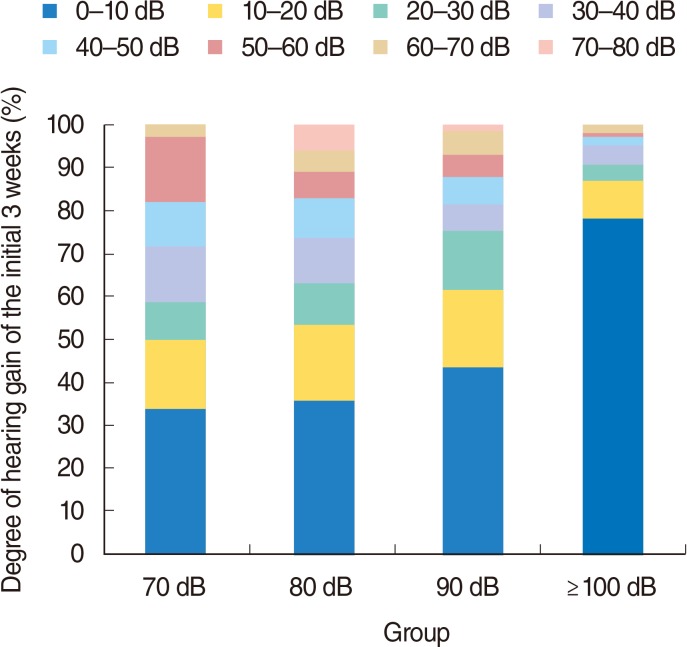Clin Exp Otorhinolaryngol.
2015 Sep;8(3):206-210. 10.3342/ceo.2015.8.3.206.
Outcomes of Severe to Profound Idiopathic Sudden Sensorineural Hearing Loss
- Affiliations
-
- 1Department of Otolaryngology-Head and Neck Surgery, Chonnam National University Hospital, Gwangju, Korea. entcnuh@gmail.com
- KMID: 2117513
- DOI: http://doi.org/10.3342/ceo.2015.8.3.206
Abstract
OBJECTIVES
While a severe to profound sudden sensorineural hearing loss (SSNHL) may cause serious disability in verbal communication, there have been little studies focusing on this high degree SSNHL. The present study was aimed to investigate the characteristics of hearing recovery in a high degree SSNHL (>70 dB).
METHODS
Three hundred and two SSNHL patients were enrolled. For a long-term follow-up, 46 patients were evaluated. Hearing level was examined by pure tone audiometry on day 1, week 3, month 3, month 6, and year 1 or after. According to the degree of the initial hearing loss, the patients were divided into 4 groups from 70 to > or =100 dB.
RESULTS
After 3 weeks, the recovery rate and mean hearing gain was 61%, 23.85 dB in the 70 dB group, whereas 10%, 6.61 dB in the > or =100 dB group. There was a significant correlation between 3-week recovery and final hearing outcome. However, there was almost no recovery after 3 months.
CONCLUSION
An early recovery can be a prognostic factor for the final recovery in severe to profound SSNHL. Since recovery after 3 months is rare, an early hearing intervention like hearing aid or cochlear implantation should be considered in the high degree SSNHL to restore the patient's verbal communication.
Keyword
MeSH Terms
Figure
Cited by 1 articles
-
3D FLAIR Cochlear Abnormality Does Not Predict on Sudden Sensorineural Hearing Loss Prognosis: A Retrospective Cohort Study
Geun Cheol Shin, Ara Cho, Min Cheol Jeong, Beom Seok Sohn, Seong Hoon Bae
Korean J Otorhinolaryngol-Head Neck Surg. 2022;65(3):143-149. doi: 10.3342/kjorl-hns.2021.00409.
Reference
-
1. De Kleyn A. Sudden complete or partial loss of function of the octavus-system in apparently normal persons. Acta Otolaryngol. 1944; 1. 32(5-6):407–429.2. Byl FM Jr. Sudden hearing loss: eight years' experience and suggested prognostic table. Laryngoscope. 1984; 5. 94(5 Pt 1):647–661. PMID: 6325838.3. Cvorovic L, Deric D, Probst R, Hegemann S. Prognostic model for predicting hearing recovery in idiopathic sudden sensorineural hearing loss. Otol Neurotol. 2008; 6. 29(4):464–469. PMID: 18434930.4. Jun HJ, Chang J, Im GJ, Kwon SY, Jung H, Choi J. Analysis of frequency loss as a prognostic factor in idiopathic sensorineural hearing loss. Acta Otolaryngol. 2012; 6. 132(6):590–596. PMID: 22497556.
Article5. Ceylan A, Celenk F, Kemaloglu YK, Bayazit YA, Goksu N, Ozbilen S. Impact of prognostic factors on recovery from sudden hearing loss. J Laryngol Otol. 2007; 11. 121(11):1035–1040. PMID: 17241495.
Article6. Narozny W, Kuczkowski J, Kot J, Stankiewicz C, Sicko Z, Mikaszewski B. Prognostic factors in sudden sensorineural hearing loss: our experience and a review of the literature. Ann Otol Rhinol Laryngol. 2006; 7. 115(7):553–558. PMID: 16900810.
Article7. Hong SM, Ko YG, Park CH, Lee JH, Kim JH. Analysis of hearing improvement in patients with severe to profound sudden sensorineural hearing loss according to the level of pure tone hearing threshold. Eur Arch Otorhinolaryngol. 2012; 9. 269(9):2057–2060. PMID: 22143582.
Article8. Lee SS, Cho HH, Jang CH, Cho YB. Fate of sudden deafness occurring in the only hearing ear: outcomes and timing to consider cochlear implantation. J Korean Med Sci. 2010; 2. 25(2):283–286. PMID: 20119584.
Article9. Siegel LG. The treatment of idiopathic sudden sensorineural hearing loss. Otolaryngol Clin North Am. 1975; 6. 8(2):467–473. PMID: 1153209.
Article10. Wilson WR, Byl FM, Laird N. The efficacy of steroids in the treatment of idiopathic sudden hearing loss: a double-blind clinical study. Arch Otolaryngol. 1980; 12. 106(12):772–776. PMID: 7002129.
Article11. Sheehy JL. Vasodilator therapy in sensory-neural hearing loss. Laryngoscope. 1960; 7. 70:885–914. PMID: 14445724.
Article12. Byl FM. Seventy-six cases of presumed sudden hearing loss occurring in 1973: prognosis and incidence. Laryngoscope. 1977; 5. 87(5 Pt 1):817–825. PMID: 850455.
Article13. Liu SC, Kang BH, Lee JC, Lin YS, Huang KL, Liu DW, et al. Comparison of therapeutic results in sudden sensorineural hearing loss with/without additional hyperbaric oxygen therapy: a retrospective review of 465 audiologically controlled cases. Clin Otolaryngol. 2011; 4. 36(2):121–128. PMID: 21414179.
Article
- Full Text Links
- Actions
-
Cited
- CITED
-
- Close
- Share
- Similar articles
-
- Clinical Application of Hyperbaric Oxygen in Treatment of Idiopathic Sudden Sensorineural Hearing Loss
- A Case of Idiopathic Sequential Profound Bilateral Sudden Sensorineural Hearing Loss Occurring 37 Days After Unilateral Presentation
- A Case of Bilateral Cochlear Implants in Bilateral Profound Sudden Sensorineural Hearing Loss After COVID-19 Infection
- Stellate Ganglion Block in Pediatric Patient with Idiopathic Sudden Sensorineural Hearing Loss : A case report
- Evaluation of Vestibular Function in Idiopathic Sudden Sensorineural Hearing Loss




